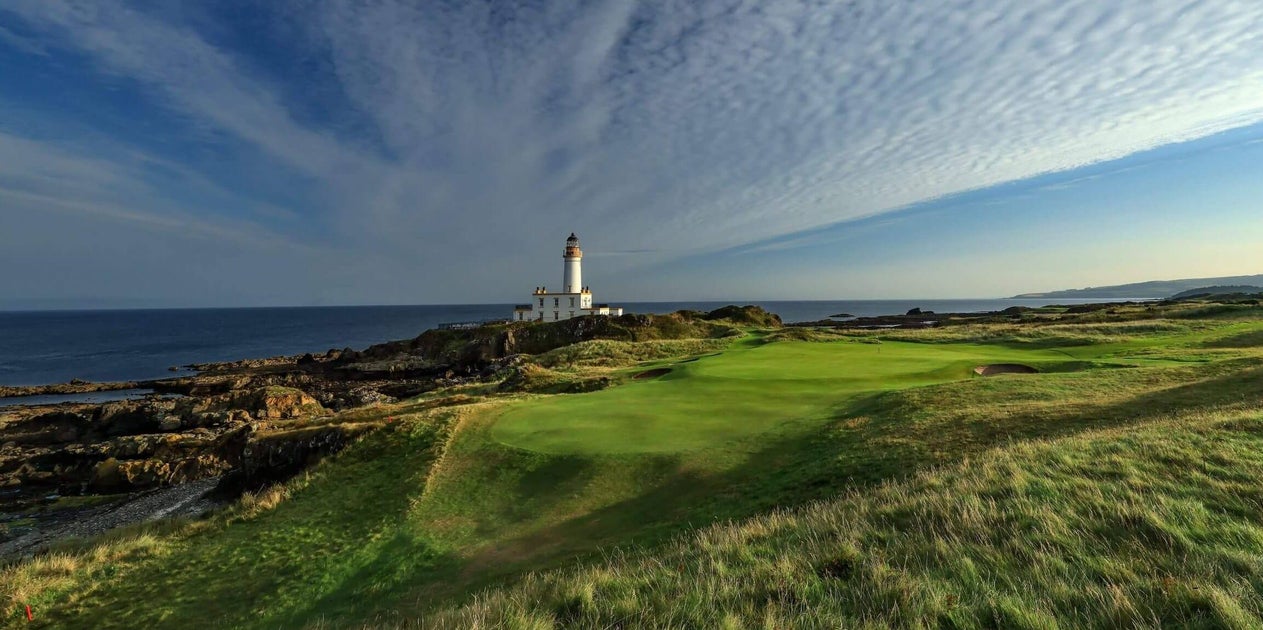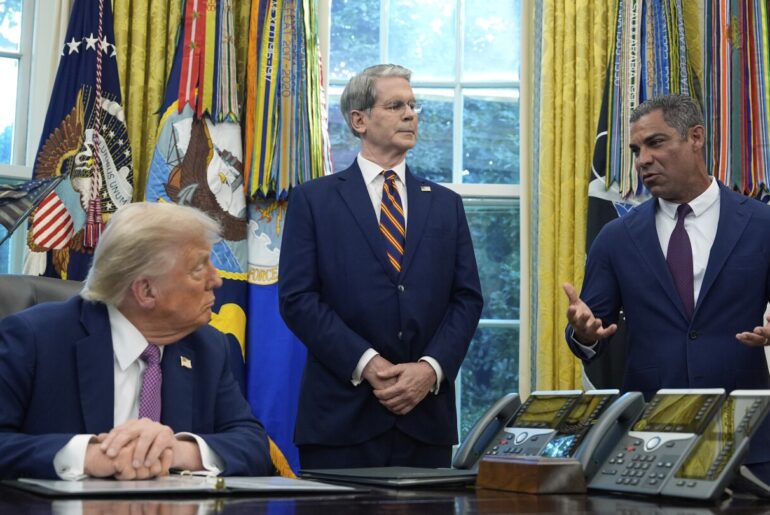Turnberry is a bucket-list course every golfer wants to play.
In peak summer time, the west Scotland venue is the most expensive round of golf you can play in the United Kingdom, and one of the priciest in the world, at £1,000 ($1,342). It’s not off-limits to the general public — if you’re willing to pay, anyone can request a tee time. But be warned, they’re hard to come by.
For the lucky ones who do play it, few depart disappointed. The lighthouse is now one of the most iconic halfway-house settings in golf. Holes nine to 11 sit pretty as arguably the best three-hole stretch anywhere in the world, and those on either side nestle nicely in the dunes to the sweet sound of the waves off the Firth of Clyde.
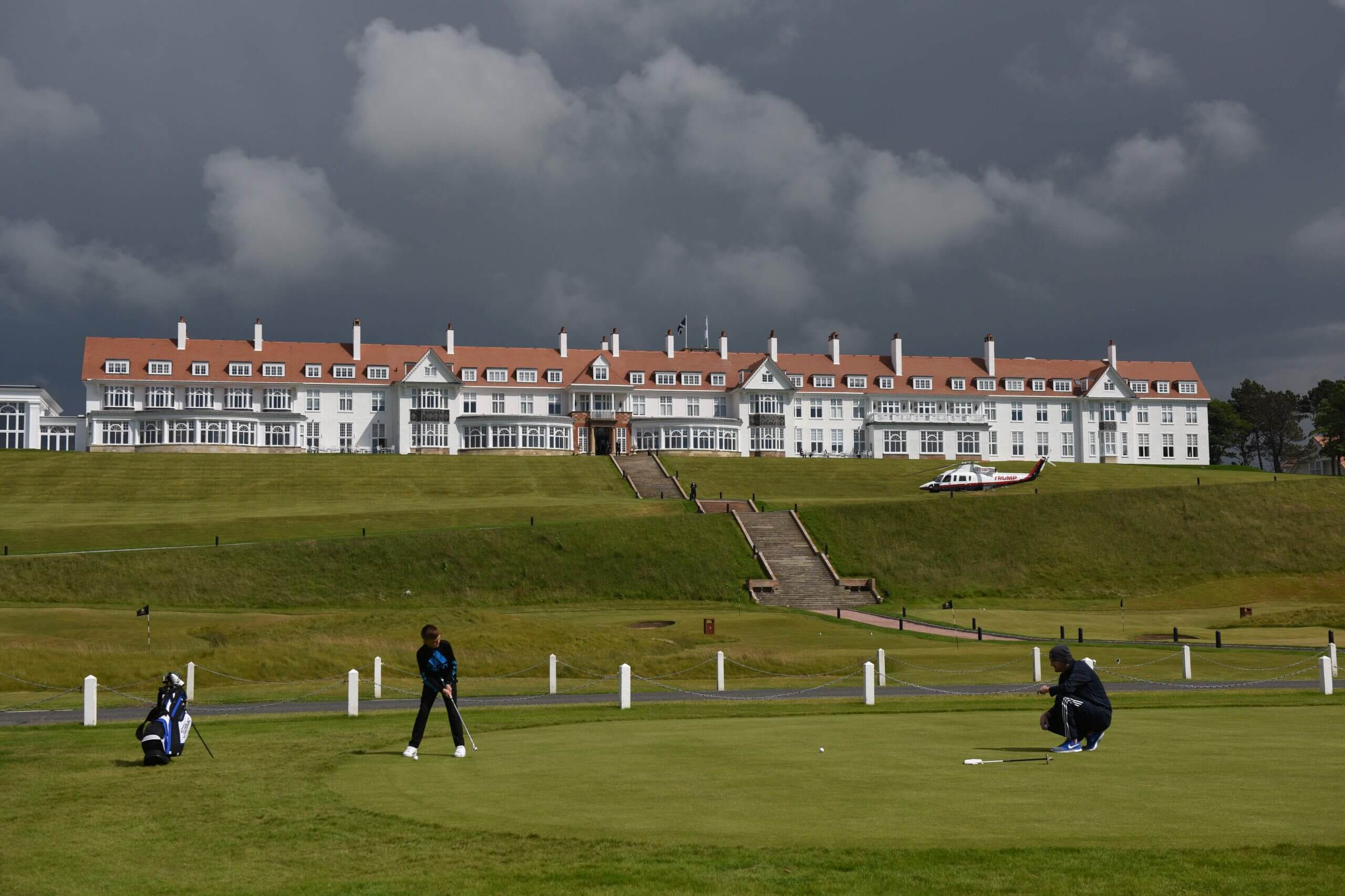
The Trump Turnberry hotel and golf resort. (Oli Scarff / AFP via Getty Images)
All of which begs the question: Why does Turnberry no longer host majors?
It is 16 years since it staged the most recent of its four Open Championships — only 10 courses have staged more in the tournament’s 165-year history — and there is little sign of that wait ending, despite it being one of the most storied courses in the sport.
The answer is complicated, and includes logistical challenges around access and local infrastructure, but a clue can also be found in what is now the course’s full name: Trump Turnberry.
The U.S. president’s ownership of the venue since 2014 has had significant upsides, but it has also bestowed considerable baggage. It’s turned the course into a regular scene of political and environmental protest and a lightning rod for anti-Trump sentiment in Scotland — and, occasionally, beyond.
It helps explain why getting people to open up on Turnberry’s exclusion from golf’s top table is no easy task.
You do not need to spend long inside Turnberry’s clubhouse or hotel to know you are in Donald Trump’s world.
Try to sum it up in a phrase and it would probably be kilt-kitsch — from the tartan-clad porters to the dazzling array of trophies and five-star reviews that adorn the walls, reminding everyone who passes just how lucky they are to be inside one of the UK’s most historic golf courses. It’s brash and brazen. Unapologetically so.

The Turnberry hotel. (Gregg Evans / The Athletic)
Some regulars love the place so much they’ve chosen it as their wedding venue. Others have visited from as far as Japan and South Korea just to park up and take a selfie outside the grounds. Or buy a club-branded bag towel (£45), or a Turnberry lighthouse Christmas tree ornament (£60).
There was, of course, a golf course here long before Trump’s takeover. It was first opened in 1901, although there were hiatuses during both World Wars, when it was used as an airfield and a hospital.
What hasn’t changed is the quality of the course. UK and Ireland golf course rankings are subjective and measured differently depending on the outlet, but Turnberry is a regular in the top five.
Dan Murphy, editor of National Club Golfer Top 100s course rankings — which ranks Turnberry third in the UK and Ireland, behind Royal County Down in Northern Ireland and St Andrews on the other side of Scotland — says: “It’s always been a very special place because of the lighthouse, the ever-distinctive Ailsa Craig granite rock out to sea, the visually stunning hotel at the top of the hill and the spectacular clifftop views. And of course, it was home to the greatest Open of all time.”
That was in 1977, when Tom Watson and Jack Nicklaus slugged it out in one of the greatest showdowns golf has ever produced, in baking conditions that are inconceivable on the grisly day The Athletic visits.
Turnberry embraces its history, and its restaurant is called The Duel in the Sun — the name given to Watson’s victory (he finished 12-under, one ahead of Nicklaus, who was 10 shots clear of third-placed Hubert Green).
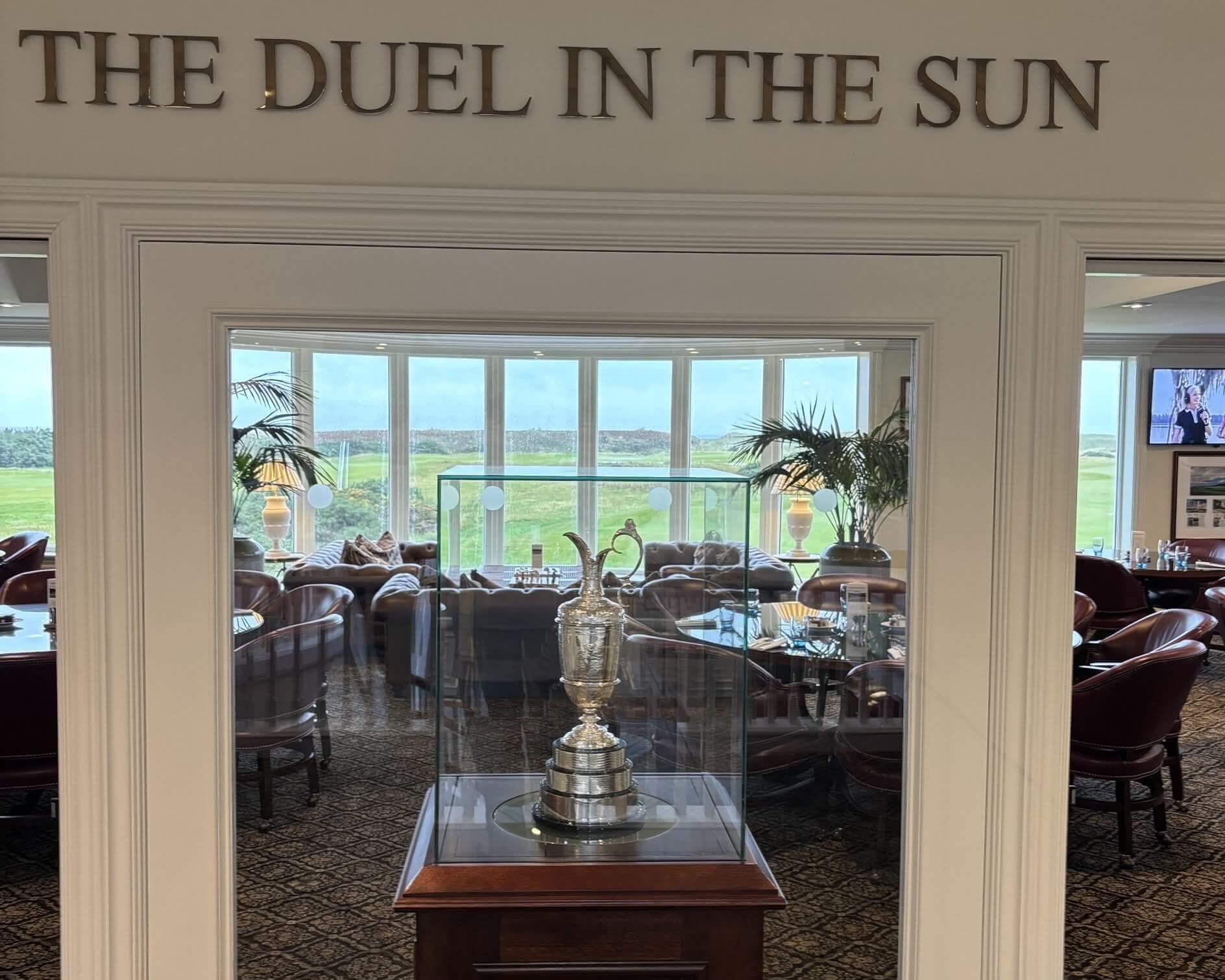
The restaurant named after Turnberry’s most famous Open battle. (Gregg Evans / The Athletic)
Photos of Watson and Nicklaus hang on the walls, and it’s hard not to wonder how different the place might feel if the 2009 Open had ended the way so many hoped it would. When Watson — then aged 59, and trying to become the oldest major winner — bogeyed the final hole and lost in a playoff, the fairytale slipped away. One staff member who attended that year said it felt like a funeral as poor Stewart Cink ruined the party to claim his first and only career major.
The red leather chairs and brown carpet look like they were designed when Watson and Nicklaus were in their prime, but they’re still in immaculate condition. The food is also suitably high-end — all dry-aged, grass-fed beef and locally sourced seafood — with views that stretch out west across the sea, although surprisingly it rarely gets busy.
At a club with two 18-hole courses — the secondary King Robert the Bruce is a beauty in its own right — not many visitors choose to dine on-site unless they’re staying in the hotel. For all the coachloads of wealthy U.S. tourists and the celebrities, it’s often only a few members who are seen sipping a post-round pint.
The chances of someone of Watson’s vintage conquering an elite field here again are slim.
Changes to the course’s layout have made it more challenging, with extra distance added to some holes and others reshaped. Heavy rain overnight means the greens are running a little slow when The Athletic visited as part of a day organised by Reflo, the sustainable performance-wear brand.
It is windy, too. Very windy. Standing on the famous ninth hole is not for the faint-hearted, as strong gusts rip apart cheap umbrellas and threaten to blow players off the elevated tee box and into the Atlantic Ocean. Club selection is troublesome, too.
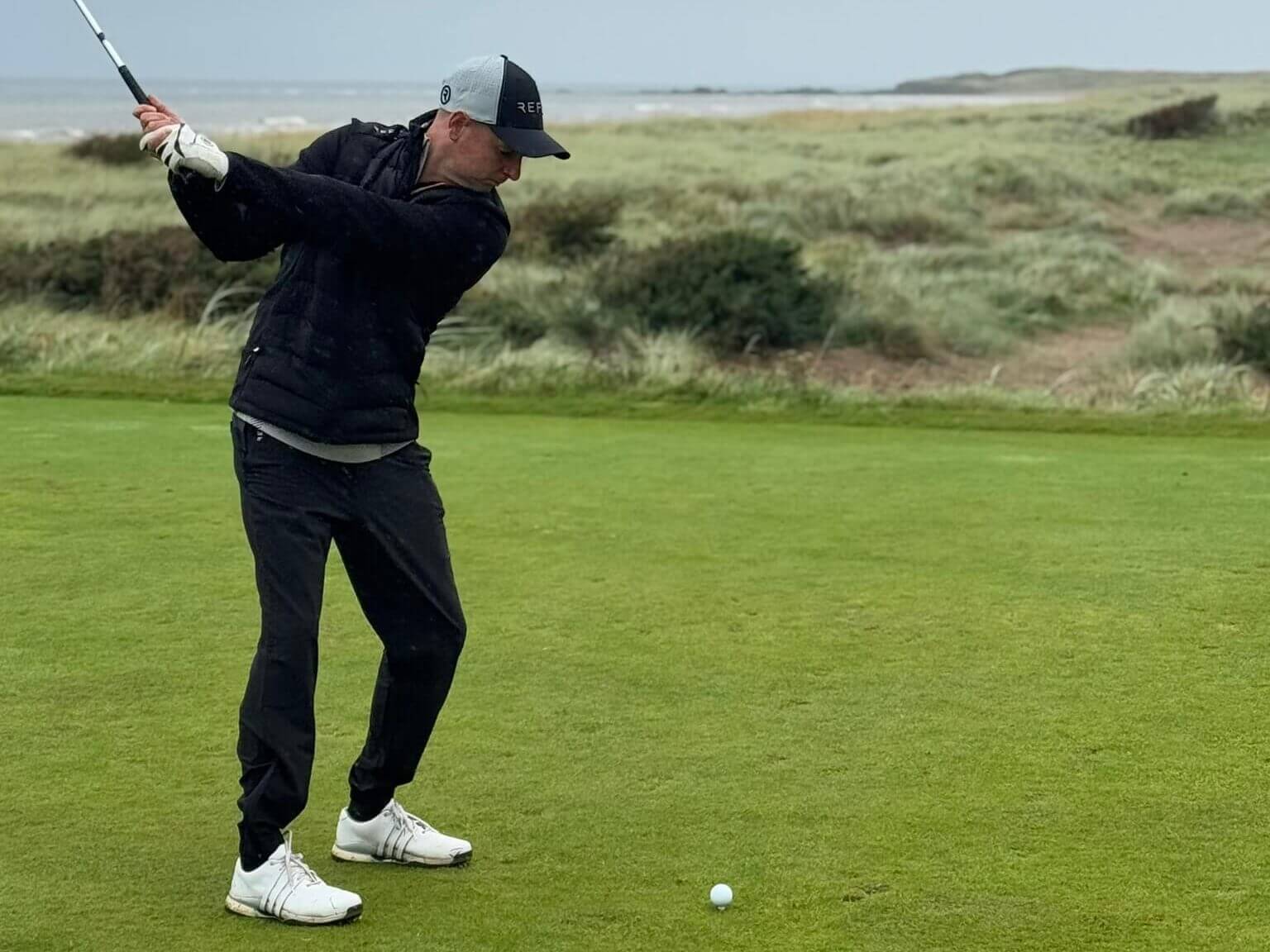
Gregg Evans plays Turnberry (Reflo)
It helps that Max Payne and Harrison Woan (Max and Harry), the content creators who specialise in trick shots, are around. Their advice on how to hit a ‘stinger’ — a shot with a piercing, low ball-flight that was once the secret weapon for Tiger Woods — comes in useful.
Links courses aren’t exactly known for their perfection — it’s more about the charm and quirks that come with playing by the sea — but Turnberry is immaculate.
It is one of about 20 courses Trump owns — a mix of public and private courses — and one of his most expensive. In the first three years after purchasing it, Trump said that he had paid around £200million on the course, with company accounts filed in the UK showing that it ran at a significant loss during that time.
He is certainly proud of his Scottish roots — his late mother was from the Isle of Lewis, in the Outer Hebrides — but Trump owning one of the country’s most prized sporting venues has been predictably divisive.
Martin Slumbers, the former chief executive of the Royal & Ancient Golf Club (R&A), which runs The Open, said golf’s oldest major would not be held at Turnberry until Trump was out of politics and the focus was solely on the sport.
The 79-year-old’s most recent visit to Turnberry, in July, prompted protests in Aberdeen, in north-east Scotland, and capital city Edinburgh. In March, a building at the resort was vandalised by a pro-Palestinian protest group. A month later, Greenpeace, the environmental campaigners, created a huge artwork on the beach below the Turnberry resort of Trump’s face with the slogan: “Time to resist — fight the billionaire takeover.”
It isn’t just Turnberry that has been the subject of controversy.
Trump’s acquisition of his first course in Scotland, at Balmedie, just north of Aberdeen, was met with fierce resistance, with concerns ranging from environmental damage to local families being forced off the land being used to build the resort, all chronicled in a 2011 documentary, You’ve Been Trumped, by filmmaker Anthony Baxter. There was another row in 2015, three years after the course had opened, when Trump tried to block the building of a wind farm two miles away, only to fail in the UK Supreme Court.

Homeowner David Milne holds up a ‘Stop The Trump Clearances’ sticker in protest at plans to build a course in Aberdeen (Derek Blair / AFP via Getty Images)
That course — now known as Trump International Golf Links — hosted a DP World Tour event in August without incident but such noise around a major would prove a significant headache for organisers.
Yet the R&A’s bigger issue is around infrastructure, namely the roads and rail services, and the lack of nearby accommodation.
The coast road leading into the small village of Turnberry is a single lane in each direction and the closest train station, Maybole, is eight miles inland. The nearest major town, Ayr (population: 46,000), is not exactly an international resort, either. Most visitors would need to fly to Glasgow (54 miles away) or Edinburgh (twice as far) and make their way cross-country from there by car or bus.
In 2009, the Open’s spectator numbers were at 120,000, but at Northern Ireland’s Royal Portrush this year, about 280,000 people attended, only made possible by road improvements around the area. Next summer at Royal Birkdale, near Liverpool, the figure is expected to be even higher, and then it’s back to St Andrews in 2027.
Slumbers’ replacement, Mark Darbon, said in July that he held talks with Trump’s son, Eric, about the logistical challenges Turnberry has, rather than politics, but how the course can overcome its problems is open to question.
Turnberry is not the only course to have met logistical challenges in its ambitions to host Opens: Muirfield, just east of Edinburgh, has not been allocated one since 2013, while Royal Lytham, on England’s north-west coast, has been waiting since 2012. The two venues have hosted 27 Opens between them but infrastructure concerns have blocked them in recent years.
The Open’s venues for 2028 and beyond have not been decided yet, but all will be revealed by the middle of next year. There are whispers that Lytham’s improvements over the past 18 months mean they now stand a good chance of hosting in 2029 but Turnberry is expected to be kept waiting unless there are big changes.

Turnberry is remote. (Jeff J Mitchell / Getty Images)
It would be understandable if this were a cause of significant frustration locally. After all, The Open represents a significant cash windfall to the areas that host it: the Northern Ireland Tourist Board estimated that hosting this year’s event was worth around £213million to the local economy around Royal Portrush.
Yet getting anyone to say so is another matter. In fact, speaking to people around the area or connected to the club at all is not straightforward: there seems to be a nagging concern that their words will be used against them.
A staff member at nearby Redgates Holiday Park admitted The Open would be good for business but, when asked by The Athletic whether they could be named, they chose to remain anonymous. Workers at Turnberry discussed their admiration for Trump, his investment, and how he’s helped create multiple jobs in the area, but also asked not to be named.
Some of the 70 caddies were concerned that hosting The Open — and potentially losing work when the course is closed for the event — would be detrimental to their livelihood. They, too, were cautious of disclosing any further details, and even the club members asked to talk in private. One told The Athletic that they thought the discussion around The Open was “more political than anything else.”
It would be no great surprise if the added media scrutiny that has fallen on this otherwise quiet corner of Scotland since Trump’s arrival had taken a toll, and put everyone on their guard. It falls to Murphy, who is freer to speak openly given his detachment from the course and the area, to articulate the issues.
“We all know there is a bit more to Turnberry’s Open-hosting prospects than the logistics, but there certainly are some challenges, it’s fair to say,” he says. “Yet it should be said, it isn’t the only notable Open venue to have logistical challenges.”
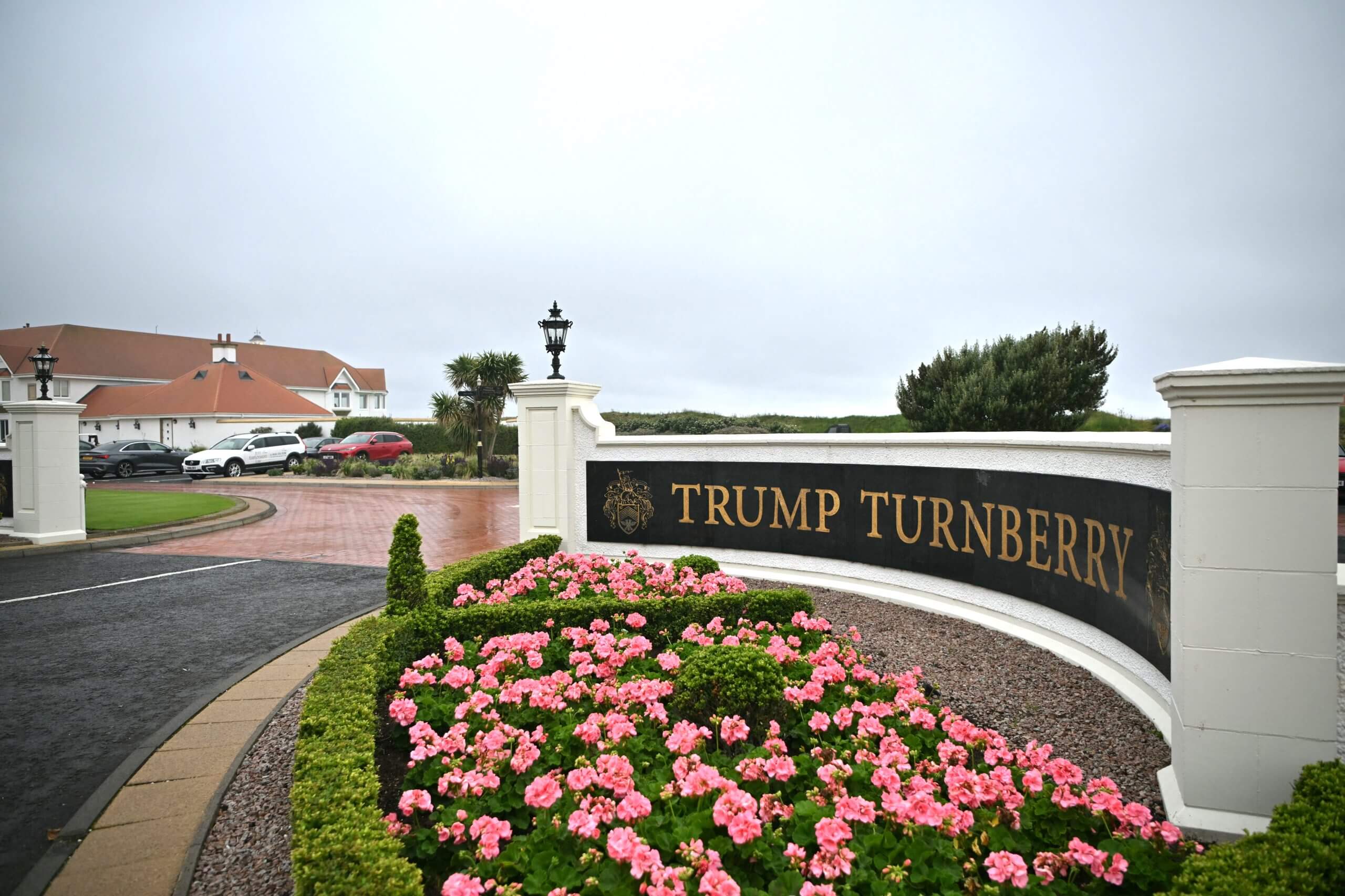
Will Turnberry return to the Open-hosting circuit? (Andy Buchanan / AFP via Getty Images)
Woan, a PGA professional who has played competitively in the past, says after sampling the course that he’s hoping to see it return in the future. The wait will certainly not be down to the quality of the course — something the R&A recognises.
In the meantime, Turnberry continues to welcome groups from dawn ’til dusk each day. It’s so busy in the summer that members struggle to get a tee time between 9am and 3pm, even with the mind-blowing £1,000-a-round green fee, although that figure drops significantly out of peak times.
In the colder, wetter months, the quality of the course remains, as does the sense of grandeur and the ever-present smell of incense.
That, too, is available in the pro shop, for at least 50 per cent more than you’ll pay elsewhere. But it does come with a branded box, as well as the memories. For most visitors, it is a price worth paying.

